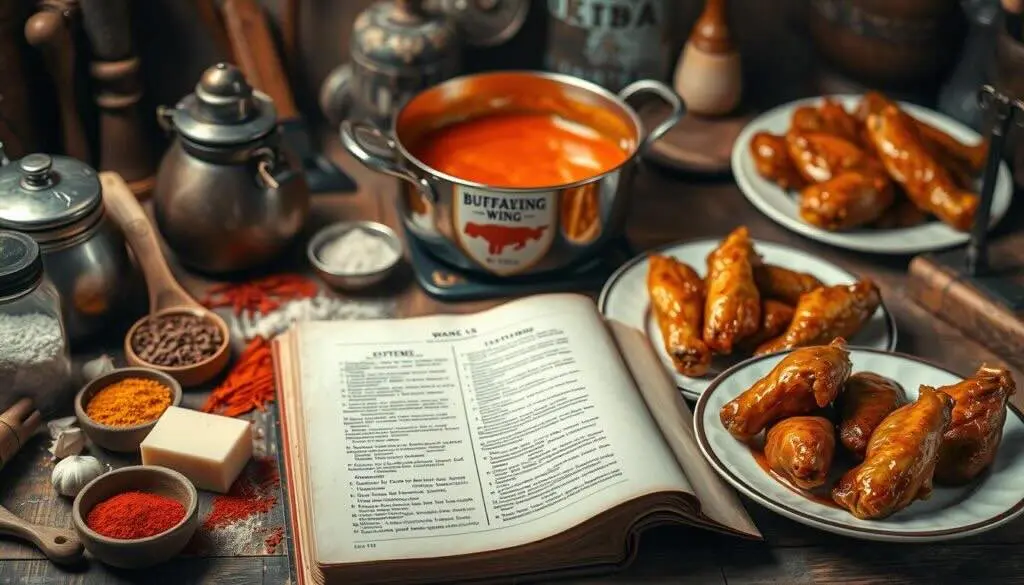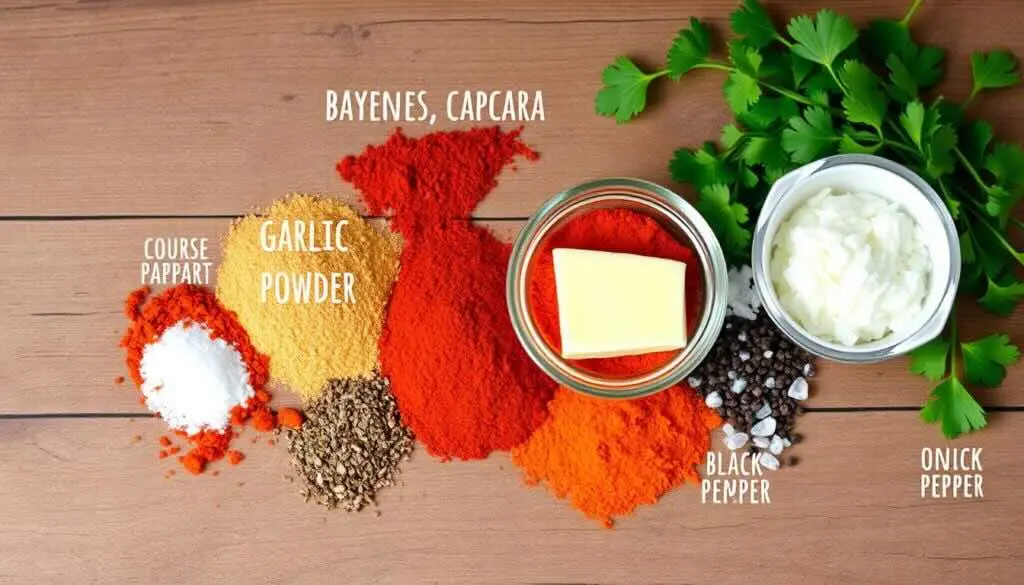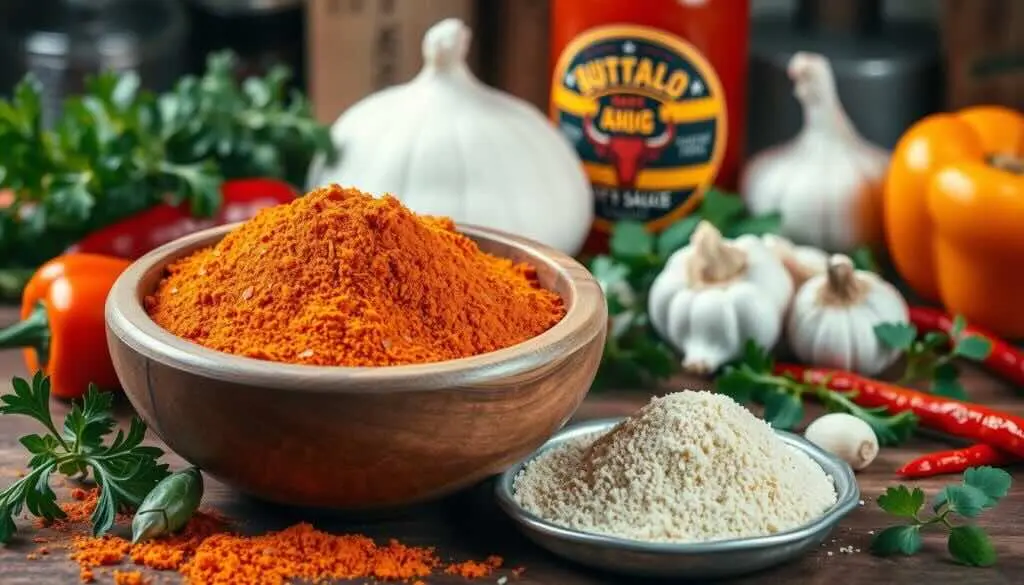Ever wondered how a simple chicken wing turns into a delicious buffalo wing? The secret is in the buffalo wing seasoning. It’s more than just sprinkling spices.
Buffalo wings started in Buffalo, New York, at the Anchor Bar in 1964. Teressa Bellissimo, the owner, created them. Since then, buffalo wing seasoning has become a favorite in America.
Making the perfect buffalo wing seasoning is both science and art. It’s about knowing how each ingredient works together. This creates the spicy, tangy taste that fans love. Every detail, from spice amounts to cooking methods, is important.
Table of Contents
Key Takeaways
- Buffalo wing seasoning is a complex blend of flavors
- Authentic wings have roots in Buffalo, New York
- Balancing heat and flavor is crucial for perfect wings
- Fresh ingredients make a significant difference
- Technique matters as much as the seasoning itself
Understanding the Art of Wing Seasoning
Buffalo wing seasoning has grown from a simple dish to a big hit. It all started in western New York at the famous Anchor Bar. There, the first buffalo wings were made.

To get buffalo wing seasoning, we need to look at its history and how it’s made. Let’s explore the exciting world of wing flavors.
The History of Buffalo Wings
The story of buffalo wings shows how food can inspire. At the Anchor Bar in Buffalo, New York, something special happened. Teressa Bellissimo created the spicy chicken wings in 1964. This idea quickly became a hit across the country.
Classic vs Modern Seasoning Approaches
- Classic Approach: Simple cayenne pepper sauce and butter
- Modern Approach: Complex, layered flavor profiles
- Traditional spice blend includes:
- Kosher salt
- Black pepper
- Garlic powder
- Cayenne powder
The Science Behind Perfect Wing Flavor
Getting the best buffalo wing seasoning is all about flavor chemistry. It’s about:
- Balancing heat intensity
- Creating depth through spice combinations
- Ensuring optimal seasoning absorption
Perfect buffalo wing seasoning is all about finding the right mix. It’s about heat, tang, and savory flavors. Your taste buds will love this journey!
Essential Ingredients for Buffalo Wing Seasoning
Making the perfect buffalo wing seasoning is an art. It’s about mixing the right ingredients to turn simple chicken wings into a tasty treat. Your seasoning is not just spices; it’s a mix of heat, flavor, and complexity.

- Cayenne pepper for intense heat
- Garlic powder for depth
- Paprika for rich color and mild warmth
- Salt to enhance overall flavor
- Black pepper for subtle spiciness
Professional chefs know that seasoning is about finding the right balance. Each spice adds to the tangy, spicy taste that fans love.
| Ingredient | Cost | Flavor Profile |
|---|---|---|
| Cayenne Pepper | $0.03 | Intense heat |
| Garlic Powder | $0.05 | Savory depth |
| Paprika | $0.05 | Mild warmth |
| Salt | $0.03 | Flavor enhancement |
When making your seasoning, try smoked paprika or onion powder for more depth. Find the spice mix that you love.
Homemade buffalo wing seasoning is also budget-friendly. With just $12.65 worth of ingredients, you can make wings that taste like they’re from a restaurant, but cost less.
The Role of Heat: Balancing Spices
Making the perfect buffalo wing seasoning is all about heat and flavor balance. It’s about knowing how to mix spices just right. This turns your wings from good to great.
Working with buffalo wing seasoning is like an art. Chefs focus on more than just heat. They aim to create a mix of flavors that excites your taste buds.
Cayenne Pepper and Heat Levels
Cayenne pepper is the main heat source in buffalo wing seasoning. You can adjust its amount to fit your taste:
- Mild: 1/4 teaspoon per batch
- Medium: 1/2 teaspoon per batch
- Hot: 3/4 to 1 teaspoon per batch
Combining Different Chili Powders
Experts say mixing different chili powders adds depth. Chipotle adds smoky flavor, and habanero brings intense heat. Tabasco sauce, with its 2,500 to 3,000 Scoville Heat Units, adds more complexity.
Temperature Control Techniques
It’s important to control the cooking temperature for flavor. Here’s what experts suggest:
- Toasting spices for 2-3 minutes to release oils
- Using a medium heat setting
- Blooming spices in oil to boost flavor
Mastering these methods will help you make buffalo wing seasoning with just the right amount of heat.
Dry Rub vs Wet Seasoning Methods
Creating the perfect buffalo wing seasoning is all about knowing the difference between dry and wet methods. Each method adds its own special touch to your wings, turning them into a flavorful treat.
Dry Rub: The Crispy Flavor Powerhouse
Dry buffalo wing seasoning is a unique way to add flavor. It usually includes:
- Salt as a base ingredient
- Sweeteners like white or brown sugar (used in 25% of recipes)
- Classic spices such as garlic powder, chili powder, and paprika
Dry rubs are great for creating a crispy outside. When done right, they make a delicious bark that keeps the flavor in. Experts say to let the rub sit on the wings for 30-60 minutes to soak up more flavor.
Wet Seasoning: Moisture and Depth
Wet buffalo wing seasoning brings a new level to your cooking. It mixes dry spices with oil or liquid to:
- Penetrate flavors deeper
- Keep the meat moist
- Give a shiny, appealing look
Pro Tip: Hybrid Approach
For the best buffalo wing taste, try mixing both methods. Make a wet rub by adding a bit of oil to your dry rub. This way, you get a crispy outside and rich flavor.
About 75% of BBQ fans like dry rubs for chicken wings. But, whether you go dry or wet, the most important thing is to experiment and find your favorite flavor.
Secret Ingredient: Baking Powder Magic
Discover the secret to making buffalo wing seasoning incredibly crispy. It’s all about using baking powder. This simple ingredient turns regular chicken wings into a crispy, golden treat that will take your cooking to the next level.
Professional chefs have long used baking powder to get the perfect wing texture. It changes the pH level of chicken skin. This makes the proteins break down, leading to a crunchy exterior.
How Baking Powder Creates Crispy Skin
The science behind crispy wings is really cool. Baking powder works with chicken skin to create tiny bubbles. These bubbles increase the surface area and help with browning. This process also makes the fat render better, giving you that crunchy texture in your buffalo wing seasoning.
- Breaks down skin proteins
- Creates tiny surface bubbles
- Accelerates fat rendering
- Promotes even browning
Proper Application Techniques
To get perfect results, follow these buffalo wing seasoning tips:
- Pat chicken wings completely dry
- Use aluminum-free baking powder
- Mix 1 tablespoon baking powder with ½ teaspoon salt
- Evenly coat wings before cooking
Try out your buffalo wing seasoning with baking powder. You’ll see how it turns your chicken wings into a crispy, tasty delight.
Mastering the Base Seasoning Blend
Creating the perfect buffalo wing seasoning starts with understanding the fundamental ingredients. Your base blend is key to turning ordinary chicken wings into a culinary masterpiece.
The core of an exceptional buffalo wing seasoning includes a mix of dry spices. These ingredients work together to create depth, heat, and complex flavor.
- Paprika: Provides rich color and mild sweetness
- Garlic powder: Adds robust aromatic notes
- Onion powder: Contributes subtle savory undertones
- Cayenne pepper: Delivers signature heat
- Salt: Enhances overall flavor intensity
Crafting your buffalo wing seasoning requires precise measurements and understanding of spice interactions. Professional chefs recommend a strategic approach to blending.
| Ingredient | Percentage | Purpose |
|---|---|---|
| Paprika | 30% | Color and mild flavor |
| Salt | 25% | Flavor enhancement |
| Garlic Powder | 15% | Aromatic depth |
| Cayenne Pepper | 10% | Heat generation |
| Other Spices | 20% | Complexity and balance |
Experiment with your buffalo wing seasoning ratios to discover your signature blend. Remember, great seasoning is about personal taste and finding the perfect balance between heat, salt, and flavor.
Buffalo Wing Seasoning Preparation Steps
Making the perfect buffalo wing seasoning needs care and precision. Your homemade mix can turn simple chicken wings into a feast. Here’s how to make a top-notch buffalo wing seasoning that will wow your guests.
Measuring and Mixing Guidelines
Getting the right amounts is key for a balanced seasoning. Follow these steps for consistent flavor:
- Use a digital kitchen scale for precise ingredient measurements
- Sift dry ingredients to remove clumps
- Mix ingredients in a large, clean bowl
Here are the seasoning amounts you should use:
| Ingredient | Quantity |
|---|---|
| Kosher Salt | 1 tablespoon |
| Garlic Powder | 1.5 tablespoons |
| Paprika | 2 tablespoons |
| Cayenne Pepper | 2 teaspoons |
Storage and Shelf Life Tips
Keeping your seasoning fresh is important. Store your blend in an airtight container away from sunlight and heat. If stored right, your seasoning will stay flavorful for up to 6 months.
Batch Sizing Recommendations
Scaling up your seasoning recipe is easy. For bigger groups, just multiply the ingredients. A standard batch makes about 24 wings or 4-5 pounds of chicken.
Pro tip: Always label your seasoning container with the date you made it. This helps keep track of freshness and ensures your wings taste great.
Cooking Techniques for Seasoned Wings
Choosing how to cook your buffalo wing seasoning changes the taste and texture. Each method has its own benefits for making your seasoned wings delicious.
- Air Fryer: Quick and crispy method
- Cooking time: 20-25 minutes at 400°F
- Flip wings halfway through cooking
- Requires minimal oil
- Oven Baking: Classic home cooking approach
- Cooking time: 45-50 minutes at 425°F
- Provides even heat distribution
- Perfect for large batches
- Deep Frying: Authentic restaurant-style wings
- Oil temperature: 360°F
- Oil depth: 1-1.5 inches
- Creates extra crispy exterior
- Grilling: Smoky flavor enhancement
- Adds charred notes to buffalo wing seasoning
- Requires careful temperature management
- Best for outdoor cooking enthusiasts
Whichever method you pick, let your buffalo wing seasoning rest on the wings for 15-30 minutes before cooking. This lets the spices soak into the meat, making the flavors stronger.
Pro tip: Always use a meat thermometer to check if wings are cooked to 165°F. This is important for safety, no matter how you cook them.
Complementary Flavors and Dipping Sauces
Adding the right dipping sauce can make your buffalo wings unforgettable. The perfect sauce can turn a simple snack into a flavorful journey. Whether you love classic tastes or new ones, there’s a sauce for you.
Dipping sauces are more than just toppings. They’re about matching flavors to make your wings stand out. Today, people are trying new and exciting sauces.
Classic Sauce Pairings
For those who love traditional wings, classic sauces are a must. These favorites have been pleasing wing fans for years:
- Blue Cheese Dressing
- Ranch Dressing
- Classic Buffalo Sauce
Modern Sauce Innovations
Now, people are looking for bold and new flavors. The chicken wing market is booming, with a focus on unique tastes.
| Sauce Category | Flavor Profile | Popularity Trend |
|---|---|---|
| Sweet Heat | Mango Habanero | High |
| International Fusion | Korean Gochujang | Growing |
| Balanced Flavor | Spicy Honey Buffalo | Emerging |
Pairing your buffalo wing seasoning with these new sauces makes it even better. The fun is in trying different combinations to find your favorite.
Troubleshooting Common Seasoning Issues
Getting buffalo wing seasoning right can be tough, even for pros. You might hit a few common bumps on your seasoning journey. These can mess up the taste and feel of your wings.
Here are the most frequent buffalo wing seasoning challenges and their solutions:
- Uneven Seasoning Distribution
- Pat wings completely dry before applying seasoning
- Use a light hand when sprinkling buffalo wing seasoning
- Gently massage seasoning into chicken skin
- Seasoning Not Sticking
- Add 1 Tbsp baking powder per 2 Tbsp of rub
- Ensure chicken surface is moisture-free
- Use light oil or egg wash as a binding agent
Temperature control is key for perfect wings. Remember these temperature tips:
| Cooking Method | Temperature | Cooking Time |
|---|---|---|
| Deep Frying | 350°F to 375°F | 8-10 minutes |
| Oven Baking | 375°F | 45-60 minutes |
| Grilling | 350°F to 400°F | 25-30 minutes |
Pro tip: Always use a meat thermometer to ensure wings reach an internal temperature of 165°F for food safety. With the right seasoning and cooking, your buffalo wings will go from good to amazing.
Make-Ahead and Storage Tips
Preparing buffalo wing seasoning ahead of time can save you a lot of effort. It also helps the flavors develop better. Your homemade buffalo wing seasoning can make your wings taste amazing every time.
Making the perfect buffalo wing seasoning needs careful planning and storage. Here are some key tips to improve your wing experience:
- Prepare buffalo wing seasoning up to 2 weeks in advance
- Store in an airtight container in a cool, dark place
- Keep away from direct sunlight and moisture
Seasoning Storage Guidelines
| Storage Location | Duration | Recommended Conditions |
|---|---|---|
| Pantry | Up to 2 weeks | Airtight container, away from heat |
| Refrigerator | Up to 1 month | Sealed glass jar |
| Freezer | Up to 3 months | Vacuum-sealed bag |
When storing seasoned wings, remember these important food safety tips:
- Refrigerate wings within 2 hours of cooking
- Store in airtight containers
- Consume refrigerated wings within 3-4 days
- Reheat to an internal temperature of 165°F
Pro tip: Label your buffalo wing seasoning with the preparation date to track freshness and ensure optimal flavor.
Conclusion
Your journey with buffalo wing seasoning has opened up a world of flavors and techniques. You’ve learned about the science of spice blends, the importance of balancing heat and flavor, and how to cook chicken wings to perfection. This knowledge transforms simple chicken wings into a feast for the senses, whether you’re hosting a game-day party or enjoying a casual dinner.
Creating amazing buffalo wings is all about experimentation and adding your own personal twist. With six spice blends and countless cooking methods at your disposal, the possibilities are endless. Remember, the quality of the meat is key, and tricks like using baking powder can elevate your wings to a crispy, golden perfection.
Now, you’re equipped to make buffalo wings with confidence. Whether you prefer dry rubs or wet marinades, classic heat or innovative flavors, you’re ready to master the art of buffalo wing seasoning. The perfect wing is about finding the right balance, being creative, and enjoying the journey of cooking.
Every batch of wings is an opportunity to refine your skills and create your own signature buffalo wing seasoning. So, start experimenting, trust your taste buds, and savor the delicious results of your hard work. Happy cooking!
FAQ: Buffalo Wing Seasoning
1. What is a basic buffalo wing seasoning recipe?
A basic buffalo wing seasoning recipe typically includes:
- 2 tablespoons paprika
- 1 tablespoon garlic powder
- 1 tablespoon onion powder
- 1-2 teaspoons cayenne pepper (adjust for heat preference)
- 1 tablespoon kosher salt
- 1 teaspoon black pepper
Mix all the ingredients thoroughly and store in an airtight container. This blend can be used as a dry rub or mixed with oil for a wet marinade.
2. How do I make buffalo seasoning powder?
To make buffalo seasoning powder, combine the following dry ingredients:
- 3 tablespoons paprika
- 2 tablespoons garlic powder
- 1 tablespoon onion powder
- 1-2 tablespoons cayenne pepper (adjust for spiciness)
- 1 tablespoon salt
- 1 teaspoon black pepper
- 1 teaspoon dried thyme (optional for added depth)
Blend the ingredients in a bowl or spice grinder for a finer powder. Store in an airtight container for up to 6 months.
3. What are the essential ingredients for buffalo wings?
The essential ingredients for classic buffalo wings include:
- Chicken wings (split into drumettes and flats)
- Buffalo wing seasoning (paprika, garlic powder, cayenne pepper, salt, and black pepper)
- Butter (for the sauce)
- Hot sauce (like Frank’s RedHot for authenticity)
- Oil (for frying or baking)
- Optional: Baking powder (for extra crispiness)
4. What is the original buffalo wings recipe?
The original buffalo wings recipe was created at the Anchor Bar in Buffalo, New York, in 1964. Here’s how to recreate it:
- Season the wings: Toss chicken wings in a light coating of salt and pepper.
- Fry the wings: Deep-fry the wings at 375°F until golden and crispy (about 10-12 minutes).
- Make the sauce: Melt ½ cup of unsalted butter and mix with ½ cup of hot sauce (like Frank’s RedHot).
- Toss the wings: Coat the fried wings in the sauce mixture.
- Serve: Pair with celery sticks and blue cheese dressing for the authentic experience.
5. Can I use buffalo wing seasoning for other dishes?
Absolutely! Buffalo wing seasoning is versatile and can be used to flavor:
- Chicken tenders or nuggets
- Popcorn
- Roasted vegetables (like cauliflower or potatoes)
- Grilled shrimp or fish
- Even snacks like nuts or chips
Its spicy, tangy profile adds a kick to any dish, making it a pantry staple for flavor enthusiasts.

